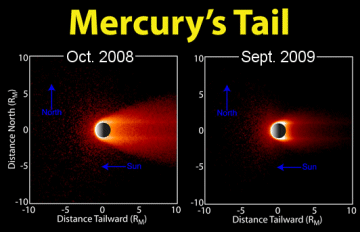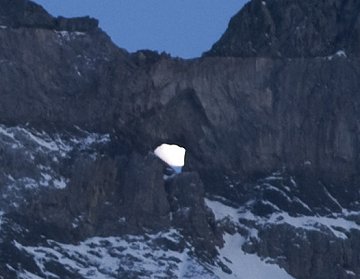| TAURID METEOR SHOWER: Earth is entering a stream of debris from periodic Comet 2P/Encke, and this is causing the annual Taurid meteor shower. The shower has a broad maximum lasting from Nov. 5th through 12th. At most, only about 5 Taurids per hour streak across the sky, but what they lack in number they make up for in dazzle. Taurid meteors tend to be fireballs, very bright and slow. Look for them falling out of the constellation Taurus during the hours around midnight. [sky map] meteor images: from John Chumack of Dayton, Ohio MERCURY'S COMET-LIKE TAIL: The ultrathin atmosphere of Mercury is blown back by solar radiation pressure, forming an enormous comet-like tail. NASA's MESSENGER spacecraft flew through that tail on Sept. 29th and found it less enormous than it used to be. The following diagram compares the situation in Oct. 2008 vs. Sept. 2009: 
Red traces the distribution of sodium atoms detected by a spectrometer onboard MESSENGER. "The neutral sodium tail, so prominent in our first two flybys of Mercury, is now significantly reduced in extent," announced planetary scientist Ron Vervack at a NASA press conference yesterday. The material in Mercury's tail comes from the surface of the planet itself, which is blasted by solar wind and micrometeorites. During MESSENGER's recent flyby of Mercury, the net effect of solar radiation pressure was small, and the sodium atoms were not accelerated away from the sun as they were during the earlier flybys, resulting in a diminished planetary tail. That's space weather. Get the full story from Science@NASA. WHAT ARE THE ODDS? A ray of light leaves the sun, travels 93 million miles, bounces off some moondust, angles toward Earth, travels another quarter million miles to Switzerland, where it threads a 10-meter hole in the Alps and passes through the lens of an onlooker's digital camera. This series of seemingly improbable events actually happened on Oct. 29th. The onlooker, Ricklin Andreas of Elm, Switzerland, took a picture to prove it: 
"The full Moon was shining through Martin's hole--a natural gap in the rock of the Tschingelhorn," explains Andreas. What are the odds? It happens about twice a year. The sun itself shines through the gap on March 12/13 and Oct. 1/2. Likewise, the full (or nearly-full) Moons of March and October are in the right position to peek through the hole, although they don't do it on the same fixed dates as the sun because of complications caused by the Moon's 27.3-day, 5o-tilted orbit. Andreas happened to be in the right place at the right time. To see the improbable, keep looking up!
October Northern Lights Gallery
[previous Octobers: 2008, 2007, 2006, 2004, 2003, 2002, 2001]
Explore the Sunspot Cycle | 
